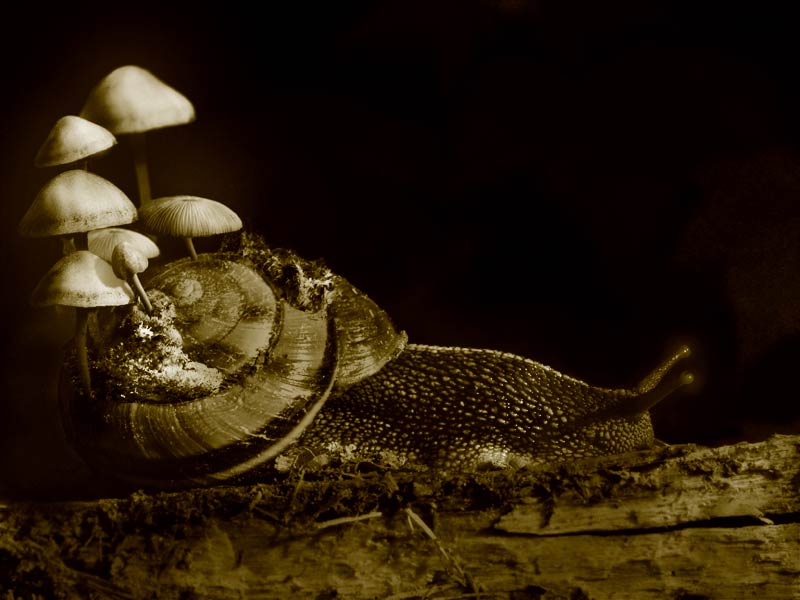
The Carrier Snail
With the steam wraith captured for the time being, I should have been able to return to my biological studies of the Park—I would have, if the monsoon season had not arrived. As of late, heavy summer rains have begun to fall upon the city, bringing flooding in the lower elevations and making the brambles even more difficult to traverse than usual.
The past two days have brought only light drizzle, so I have bravely ventured forth in search of new sights to document in the name of Science. Yesterday, I made quite a discovery, one about which I am very pleased to share with you.
I have long found the concept of mutualism a fascinating subject. How do two species evolve to rely upon one another for their mutual survival? Normally, the relationship between species is quite antagonistic, but under unusually and poorly understood circumstances, a kind of truce comes into existence. Such is the case of the carrier snail and its relationship and a previously undescribed poisonous mycoid.
I stumbled upon this unusual pairing quite by accident. My trousers, being in a terrible state of disrepair mostly due to my absent-minded neglect, have developed holes in the pockets—probably caused by my hasty pocketing of various instruments in the field. I was strolling down a muddy path when I heard the clatter of coin fall out of my pockets, bounce from my boots, and into the mud.
It is my passionate belief that if one looks closely enough, every square inch of soil will reveal to you amazing sights. We are too often caught up in the bustle of life and do not take the time to examine the smaller things. Most residents of the City give not a thought to the variety of life that abounds here. It is not due to a lack of interest—at dinner parties, I am often the center of attention when I discuss my latest discoveries. The modern lifestyle, with its focus on punctuality and efficiency, has blinded us to the smaller mysteries. Even I must pass over many discoveries in my hurry to make some appointment or examine something larger and more charismatic.
So I cannot say that I was surprised when I bent down to recover my lost coins to discover an unusual string of tiny mycoids glowing faintly in the underbrush. It is not unusual to discover circles of mushrooms growing within the Park, especially after the monsoon rains, but I have never seen a line such as this, nor a species not subterranean that glows with bioluminescence.
I took samples of course, tucking them away in cheesecloth among my tools and on a whim, followed the line of mushrooms as it led away from the path I had been following. The mushrooms grew larger with time, and so I determined that whatever was responsible for the unusual pattern was a vector with a direction. I turned about and followed the trail of little lights as they grew smaller. It was not long before I spotted the beautiful gastropod captured here.
Adorned as it was with mature specimens of the mycoid, it was easy to conclude that the snail was the source of the trail. As I watched, it inched along carefully. The mature mycoids rooted upon its shell brushed against the undergrowth now and then, and with each contact, a puff of glowing spores were ejected into the air.
At first I suspected a simple case of parasitism, and if not that, perhaps commensalism. However, the gastropod appeared to be in perfect health, so I discarded the notion of parasitism. It was clear that the mycoid was using the snail, slow as it was, to help disseminate its spores. Given the bioluminescent glow, I suspect that both species originate beneath the soil, and the monsoon rains flooded their native habitat, forcing the snail to climb to the surface and avoid drowning.
It was not until after I conducted experiments on samples in my laboratory this morning that I was able to conclude that the relationship was in fact mutualistic. I performed a very form of toxic screening with several captured specimens of rodents, moth pixies, and a boggart that had been brought to me in recent days. Most pointedly ignored the samples. One mouse ate the sample, and expired within minutes, quite painfully.
My hypothesis is that the mycoid is unable to rely on wind to disperse its spores in the still air in the cave systems in which it resides. It gains a reproductive advantage by latching onto the snail’s shell. In turn, the snail gains protection against predators, which are, based on my brief experiment, well aware of the poisonous nature of the mycoid, avoiding it and carrier snails as a kind of “umbrella effect.”
I hope to find more specimens of the snails so that I can study them further. In particular, I would like mature specimens of the mycoid to examine the chemistry behind their glow.
I have been unable to develop a theory regarding why the mycoid glows as it does. I can thing of no benefit that the light provides to the mycoid itself. Perhaps you, my trusted readers, can offer theories on this small scientific puzzle?

You can follow any responses to this entry through the RSS 2.0 feed. Both comments and pings are currently closed.
- Faery Wintering Nests
LOGGED »12-08-2008 - The Deadly Mr. Whiskers
LOGGED »11-17-2008 - The Inkblot Spider and Her Prey
LOGGED »11-10-2008 - A Hawk’s Meal
LOGGED »11-03-2008 - Field Sounds: The Word of Shallis
LOGGED »10-27-2008 - An End to the War and a Friendship
LOGGED »10-20-2008